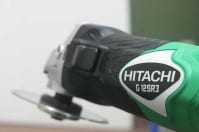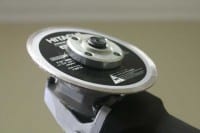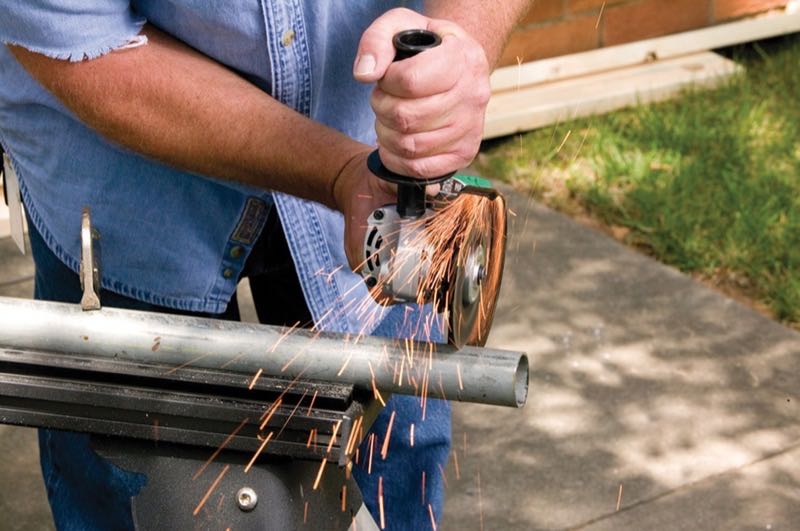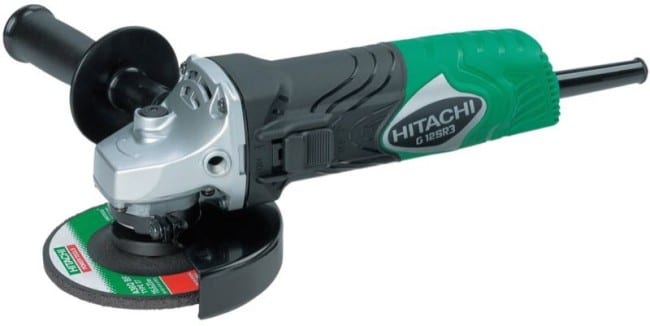There are certain tools that simply should be in your arsenal. While a nice cordless angle grinder may be something you want to look at for on-site use, a corded model like the Hitachi G12SR3 grinder is also a great choice for those looking for a basic multipurpose grinding tool. Its ease of use and low street price makes this an easy pick for almost anyone. In addition, the G12SR3 is lightweight, so you won’t feel like you’re getting a workout out as you use the tool.
Build Quality
The G12SR3 continues Hitachi’s svelte trend with a narrow body that is part die-cast and part plastic. The grinder comes with a nice Hitachi plastic tool case that has plenty of room for spare blades and can store the wheel guard and side handle which no respectable handyman will ever likely use. The kit includes 5 (count ’em) grinder wheels that are meant for steel applications, making this a metalworker’s tool right out of the box. These discs (which are worth about $10 retail by themselves) are perfect for cutting off bolts, hacking into galvanized pie, or cleaning up your welds. Right off the bat we purchased a diamond wheel to use with tile applications – a great alternative to a wet saw and something that greatly simplifies the process of installing custom tile.
 The grinder is activated by a side-mounted thumb switch that we found easy to use, though not as easy as some Dewalt paddle switches we’ve seen. Pushing the switch all the way up automatically locks it in place and allows extended use of the tool without having to keep the switch physically depressed. The G12SR3 has replaceable brushes that can be accessed by removing the front four screws that hold the plastic shell and the rear tap screw that holds the housing assembly in place. Pulling it off gets you access to the two carbon brushes. It’s not the simplest process (and certainly not externally accessible as Hitachi would have you believe), but it’s definitely serviceable for those who aren’t afraid to get in there with a screwdriver and do the work.
The grinder is activated by a side-mounted thumb switch that we found easy to use, though not as easy as some Dewalt paddle switches we’ve seen. Pushing the switch all the way up automatically locks it in place and allows extended use of the tool without having to keep the switch physically depressed. The G12SR3 has replaceable brushes that can be accessed by removing the front four screws that hold the plastic shell and the rear tap screw that holds the housing assembly in place. Pulling it off gets you access to the two carbon brushes. It’s not the simplest process (and certainly not externally accessible as Hitachi would have you believe), but it’s definitely serviceable for those who aren’t afraid to get in there with a screwdriver and do the work.
Blade changes are a snap as the grinder has a push button that sets the lock pin and prevents the wheel from spinning. The button is very easy to depress with not much resistance. The included wrench allows for plenty of torque that both holds and releases wheels and discs with ease. Blade changes took on average about 20 seconds to complete – that’s fast. We were able to switch between masonry, metal and diamond wheels with little to no effort at all.
Ergonomics and Use
 For as powerful a tool as this is, it felt light in the hands compared to some of the competition. Though Hitachi claims the grinder weighs only 3.1 pounds, we actually found it to come in at 4 pounds 3 ounces – and that was without the handle and wheel guard. It still felt light to us. We liked the way it allowed us to easily manipulate the position of the tool and hold it steady while curving around tile and making complex cuts. The thumb switch continued to be easy to use and we got used to locking it into place with a single, fluid movement. This is also an easy tool to use one-handed, which was critical in our practical tile and hardiboard applications.
For as powerful a tool as this is, it felt light in the hands compared to some of the competition. Though Hitachi claims the grinder weighs only 3.1 pounds, we actually found it to come in at 4 pounds 3 ounces – and that was without the handle and wheel guard. It still felt light to us. We liked the way it allowed us to easily manipulate the position of the tool and hold it steady while curving around tile and making complex cuts. The thumb switch continued to be easy to use and we got used to locking it into place with a single, fluid movement. This is also an easy tool to use one-handed, which was critical in our practical tile and hardiboard applications.
Field Testing
To fully test the grinder, we removed the side handle and blade guard (sorry UL). We then started by cutting out patterns in hardiboard, which made for incredibly fast results that would have taken much longer (and been more difficult) with a jigsaw and masonry blade. We had done some comparisons with the angle grinder, a circular saw, and a miter saw for various cuts. In the end, we ended up putting away the miter saw and using the angle grinder for all but extended rip cuts. This was much quicker, more accurate and allowed us to make complex cuts with ease. The Hitachi never bound up and sliced through Hardiboard like it was rather thick butter.
 We then turned our sights towards tile. While using a full-size tile saw like the new Ridgid R4040S 8″ wet tile saw might be great for larger jobs, sometimes it’s nice to have a diamond wheel on your angle grinder for small cuts. We used the Hitachi G12SR3 to cut the corners off 12×12 tile in order to place inset marble tiles within for a wall pattern we were creating in a bathroom project (it pays to be in the middle of renovation projects when reviewing tools). The angle grinder made short work of slicing through the ceramic tile and we found that we could also do easy circular cuts in the tiles for the toilet drain pipe outlet. Not only were these cuts easy to make, but they were easy to make one-handed and with a clean line-of-sight to the cutting line. In any cutting tool this is important, but with precision tile cuts it’s absolutely essential. Even though you can get by with rougher cuts around a toilet, it’s great to be able to do it right and have an exact circle in the tile with very little effort. It also makes a nice impression should the client walk in while you’re at this stage in the project.
We then turned our sights towards tile. While using a full-size tile saw like the new Ridgid R4040S 8″ wet tile saw might be great for larger jobs, sometimes it’s nice to have a diamond wheel on your angle grinder for small cuts. We used the Hitachi G12SR3 to cut the corners off 12×12 tile in order to place inset marble tiles within for a wall pattern we were creating in a bathroom project (it pays to be in the middle of renovation projects when reviewing tools). The angle grinder made short work of slicing through the ceramic tile and we found that we could also do easy circular cuts in the tiles for the toilet drain pipe outlet. Not only were these cuts easy to make, but they were easy to make one-handed and with a clean line-of-sight to the cutting line. In any cutting tool this is important, but with precision tile cuts it’s absolutely essential. Even though you can get by with rougher cuts around a toilet, it’s great to be able to do it right and have an exact circle in the tile with very little effort. It also makes a nice impression should the client walk in while you’re at this stage in the project.
Conclusion
The angle grinder really seemed to be a one-stop shop for many applications throughout many of our in-house test projects – which is why it’s one of our “mandatory” handyman tool suggestions for those looking to equip themselves for multiple projects around the house. We found the Hitachi G12SR3 4-1/2 inch 6 amp angle grinder to be an easy to use tool that should be at the top of any handyman’s short list. Price, performance and ease of use make this an easy pick. For $50 there’s no excuse for you to not have one in your arsenal.




